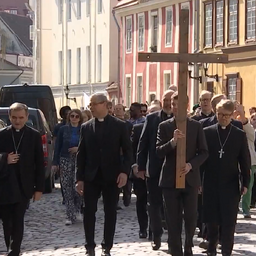Kristlaste jaoks on
suur reede
väga tähtis päev. See on vaikse nädala kõige süngem päev. Ristitee läbi Tallinna vanalinna aitab meil mõelda kannatusest, hoolivusest ja lootusest.
suur reede
Tõlge fraasile: suur reede
EN
Good Friday
Ristitee algas Tallinna Piiskoplikust Toomkirikust. Ristiteel on
14 peatust
. Need on jagatud erinevate kirikute vahel. Peatused tulid kasutusele juba keskajal. Need näitavad olulisi hetki Jeesuse elus. Näiteks, kui ta süüdi mõisteti ja kui ta risti võttis.
14 peatust
Tõlge fraasile: 14 peatust
EN
14 stations
Esimest korda viis ristitee
õigeusu kirik
usse. See on Eesti
apostlik-
õigeusu kirik
"
data-translations='{"en":"Apostolic Orthodox Church","ru":"Апостольская православная церковь","uk":"Апостольська православна церква"}'
data-article-title=""
data-article-id="87563612-4152-4d55-baeb-1264e3c82267"
aria-label="Save phrase"
title="Salvesta fraas">
-->
u peakirik Tallinnas. Tänavu tähistavad läänekristlased ja idakristlased ühtelugu suurt reedet.
õigeusu kirik
Tõlge fraasile: õigeusu kirik
EN
Orthodox church
õigeusu kirik
Tõlge fraasile: õigeusu kirik
EN
Orthodox church
õigeusu kirik
Tõlge fraasile: õigeusu kirik
EN
Orthodox church
apostlik-
õigeusu kirik
õigeusu kirik
Tõlge fraasile: õigeusu kirik
EN
Orthodox church
Tõlge fraasile: apostlik-
õigeusu kirik
õigeusu kirik
Tõlge fraasile: õigeusu kirik
EN
Orthodox church
EN
Apostolic Orthodox Church
Õigeusu kirikus asub
märterpiiskop Platon
i haud. Kirikul on pikk ja huvitav ajalugu. Kirik on olnud kasutusel 800 aastat. Sellest on osa katoliiklik, luterlik ja õigeusu aeg.
märterpiiskop Platon
Tõlge fraasile: märterpiiskop Platon
EN
Martyr Bishop Platon
Ristitee peatused olid ka
Oleviste kirik
us,
Peeter-Pauli katedraal
is ja
Jaani kirik
us.
Kaarli kirik
jäi seekord teekonnast välja. Praost Jaak Aus ütles, et liiga palju kirikuid teeb teekonna pikaks.
Oleviste kirik
Tõlge fraasile: Oleviste kirik
EN
St. Olaf's Church
Peeter-Pauli katedraal
Tõlge fraasile: Peeter-Pauli katedraal
EN
St. Peter and Paul's Cathedral
Jaani kirik
Tõlge fraasile: Jaani kirik
EN
St. John's Church
Kaarli kirik
Tõlge fraasile: Kaarli kirik
EN
Charles' Church
Ristitee traditsioon on vana ja sellel on katoliiklik taust. Tallinna
ristitee traditsioon
sai alguse
Kaarli kirik
ust. Ühel hetkel ei mahtunud rahvas kirikusse ära ja nii sai alguse
ristitee rännak
, mis ühendab erinevaid kirikuid.
ristitee traditsioon
Tõlge fraasile: ristitee traditsioon
EN
Way of the Cross tradition
Kaarli kirik
Tõlge fraasile: Kaarli kirik
EN
Charles' Church
ristitee rännak
Tõlge fraasile: ristitee rännak
EN
Way of the Cross walk
For Christians, Good Friday is a very important day. It is the most somber day of Holy Week. The Way of the Cross through Tallinn's Old Town helps us reflect on suffering, compassion, and hope.
The Way of the Cross began at the Tallinn Cathedral. The Way of the Cross has 14 stations. These are divided among different churches. The stations were introduced already in the Middle Ages. They represent significant moments in Jesus' life. For example, when he was condemned and when he took up the cross.
For the first time, the Way of the Cross led to an Orthodox church. This is the main church of the Estonian Apostolic Orthodox Church in Tallinn. This year, Western Christians and Eastern Christians are celebrating Good Friday together.
The Orthodox church houses the grave of Martyr Bishop Platon. The church has a long and interesting history. The church has been in use for 800 years. It has been part of the Catholic, Lutheran, and Orthodox periods.
The Way of the Cross also had stops at St. Olaf's Church, St. Peter and St. Paul's Cathedral, and St. John's Church. This time, St. Charles' Church was left out of the journey. Dean Jaak Aus said that too many churches make the journey long.
The tradition of the Way of the Cross is old and has a Catholic background. The tradition of the Way of the Cross in Tallinn began at St. Charles' Church. At one point, the people could not fit inside the church, and thus began the Way of the Cross procession, which connects different churches.

